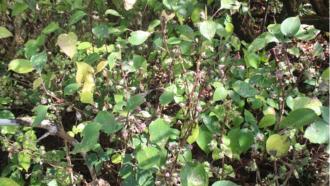
A view of the forest canopy - Photo: KS Seshadri
Tropical rainforests are unique ecosystems that support critical ecological functions. They are not just trees and animals, but an inclusive ecosystem of various taxonomic groups. One of the lesser-known components of this diverse ecosystem in India is the forest canopy. The emerging field of canopy ecology is largely associated with studying flora and fauna found high up on the treetops of the tropical forests.
The forest canopies support species ranging from insects to plants. Changes or damage to any species or components of the ecosystem can cause imbalance and affect the larger community structure, which may have long-term ecological implications. Epiphytes are one group of plants that grow profusely in the forest canopy. They grow on other plants or trees and are devoid of any connection to the soil, and absorb all nutrition with specialized roots.
A team of researchers from the Ashoka Trust for Ecology and the Environment (ATREE) and at the Centre for Ecological Sciences, Indian Institute of Science (IISc) have recently documented the impact of selective logging of trees on the epiphytic community in the Western Ghats. The study reveals that although it has been over 3-4 decades that the logging stopped, their effects continue to persist and impact the epiphytic community. The study has been published in the journal Frontiers for Forests and Global Change.
For a long time, canopy research was not undertaken due to lack of access and so forest canopies have been called the last biological frontier. One must recall Dr Nalini Nadkarni, an Indian origin American ecologist who pioneered the field of canopy ecology primarily with her work in the tropical forests of Costa Rica during the 1980s. With enhanced techniques to reach the canopy, researchers are showing renewed interest in studying canopy ecology.
“Forest canopies are the first layer to interact with the atmosphere and form the roof of our forest ecosystems and yet, our knowledge about this important ecosystem is incredibly sparse,” said Dr Soubadra Devy, a Senior Fellow at ATREE, and the senior author of the published study.
Dr Devy pioneered canopy ecology in India during the 1990s when she conducted pollination biology experiments in the tall forest canopy with nothing but rickety ladders.
In this first-of-its-kind study, researchers used a ‘Single-Rope Technique’ to gain access to the canopy.
“We had to climb trees to study the epiphytes because they would not be visible from the ground. However, dangling 100 feet above ground is not for the faint at heart, the single-rope technique is incredibly safe but requires a high level of fitness and agility” said Dr Seshadri KS, the lead author of this study who is currently a DST-INSPIRE Faculty Fellow at the Centre for Ecological Sciences, Indian Institute of Science.
“Climbing into the forest canopy changes one’s perception of scale in the forest. Everything on the ground looks relatively tiny and insignificant”, he adds.
The researchers have carried out the study on epiphyte ecology in the remote forests of the Kalakad Mundanthurai Tiger Reserve in Tamil Nadu. For studying the epiphytes, the researchers surveyed 100 trees each in an area that was selectively logged for trees up until the 1980s and an unlogged area. They found 2129 individuals of epiphytes, belonging to 20 species growing on 22 species of host trees. A large proportion of epiphytes were orchids (85%) in both selectively logged and unlogged areas.
The study notes that the epiphytic community is distinctly altered as evidenced by the increase in diversity and abundance of epiphytes in the selectively logged forest. They further found that the association of epiphytes to its host was altered too as more epiphytes were found overlapping with each other to a greater extent in the selectively logged forest. One host tree species, Cullenia exarillata, hosted the highest diversity and abundance of epiphytes in both logged and unlogged forests. Overall, taller trees with profuse growth of moss hosted a greater number of epiphytes.
The availability of moisture high up in the canopy plays a crucial role for epiphytes to assimilate nutrition from the dead and decaying material collected on the branches.
“Because of selective logging of trees, the unbroken canopy of the forest is broken. The gaps created would alter the temperature and humidity profiles. There is an increased light irradiance in the selectively logged forest and a combination of these factors may be the reason why we see greater diversity and abundance of epiphytes in the selectively logged forest” says Dr Seshadri.
“Epiphytes in the canopy reproduce by dispersing microscopic seeds or spores which are dispersed by wind. If the seeds or spores fall on branches that have greater light or have abundant growth of moss, then the chance of the epiphyte colonizing is greater as moss acts like a sponge and holds moisture” he remarks.
Evidently, the researchers caution against using the findings of increased epiphyte abundance in logged areas as an excuse to continue logging trees. Earlier, the research team has studied the impacts of logging on various taxonomic groups like amphibians, butterflies and vegetation in the same study area. They have also attempted to archive the regeneration of forests in the Kalakkad Mundanthurai Tiger Reserve. In all cases, the selectively logged forest communities are drastically different from the unlogged forest even after 3-4 decades since selective logging of trees in the Kalakad region stopped and the forests were made a part of the tiger reserve.
A different study carried out by the National Centre for Biological Sciences (NCBS), Bengaluru, and Nature Conservation Foundation (NCF), Mysuru, have shown how even a few instances of selective tree-cutting impacts biodiversity and carbon storage of the Andaman forests.
The present study on epiphytes offers a sneak-peek of how epiphytic plants would cope with disturbance and throws up more intriguing questions on the growth rate, physiology and population biology of epiphytes in the Western Ghats. Hopefully, in the days to come there will be many more researchers getting into canopy research and seeking answers to some of these questions.
This article has been run past the researchers, whose work is covered, to ensure accuracy.
An edited version of this article was earlier published in Deccan Herald.






